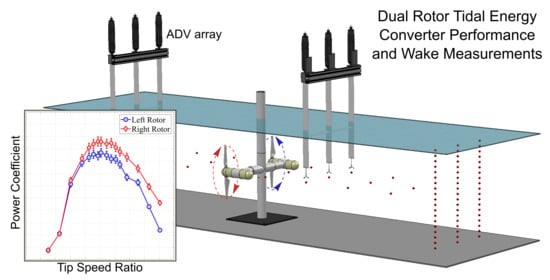Performance and Wake Characterization of a Model Hydrokinetic Turbine: The Reference Model 1 (RM1) Dual Rotor Tidal Energy Converter
Abstract
:1. Introduction
2. Materials and Methods
2.1. Blade Design
2.2. Data Reduction Methods
2.3. Uncertainty Analysis
3. Results
3.1. Inflow Characteristics
3.2. Turbine Performance
3.3. Wake Characteristics
4. Discussion
4.1. Turbine Performance
4.2. Wake Characteristics
5. Conclusions
Author Contributions
Funding
Acknowledgments
Conflicts of Interest
Appendix A. Blade Geometry Details
| 0.21 | 0.12 | 1.00 | 13.16 |
| 0.24 | 0.12 | 1.00 | 13.16 |
| 0.27 | 0.14 | 0.85 | 13.16 |
| 0.29 | 0.19 | 0.52 | 13.16 |
| 0.32 | 0.23 | 0.31 | 13.16 |
| 0.35 | 0.25 | 0.19 | 13.16 |
| 0.37 | 0.26 | 0.15 | 13.16 |
| 0.40 | 0.26 | 0.15 | 11.28 |
| 0.43 | 0.25 | 0.15 | 10.24 |
| 0.45 | 0.25 | 0.15 | 9.43 |
| 0.48 | 0.24 | 0.15 | 8.76 |
| 0.51 | 0.23 | 0.15 | 8.17 |
| 0.53 | 0.22 | 0.15 | 7.64 |
| 0.56 | 0.21 | 0.15 | 7.16 |
| 0.59 | 0.21 | 0.15 | 6.70 |
| 0.61 | 0.20 | 0.15 | 6.27 |
| 0.64 | 0.19 | 0.15 | 5.86 |
| 0.67 | 0.18 | 0.15 | 5.46 |
| 0.69 | 0.18 | 0.15 | 5.07 |
| 0.72 | 0.17 | 0.15 | 4.69 |
| 0.75 | 0.16 | 0.15 | 4.31 |
| 0.77 | 0.16 | 0.15 | 3.93 |
| 0.80 | 0.15 | 0.15 | 3.55 |
| 0.83 | 0.15 | 0.15 | 3.17 |
| 0.85 | 0.14 | 0.15 | 2.78 |
| 0.88 | 0.14 | 0.15 | 2.38 |
| 0.91 | 0.13 | 0.15 | 1.98 |
| 0.93 | 0.13 | 0.15 | 1.57 |
| 0.96 | 0.13 | 0.15 | 1.14 |
| 1.00 | 0.12 | 0.15 | 0.70 |
Appendix B. Performance Testing Summary
| 60 | 1.50 | 0.69 | 4.32 | 1.050 | −0.010 | 0.008 | 4.05 | 0.0026 | 114.03 | 0.038 |
| 90 | 2.25 | 1.25 | 11.73 | 1.048 | −0.011 | 0.006 | 4.79 | 0.0031 | 113.49 | 0.106 |
| 120 | 2.99 | 2.86 | 35.94 | 1.050 | −0.011 | 0.003 | 4.89 | 0.0031 | 114.22 | 0.321 |
| 150 | 3.76 | 2.88 | 45.24 | 1.045 | −0.010 | 0.005 | 4.92 | 0.0031 | 112.63 | 0.410 |
| 168 | 4.22 | 2.83 | 49.73 | 1.042 | −0.012 | 0.003 | 4.89 | 0.0030 | 111.63 | 0.455 |
| 180 | 4.54 | 2.70 | 50.92 | 1.039 | −0.008 | 0.003 | 4.87 | 0.0029 | 110.69 | 0.469 |
| 192 | 4.85 | 2.57 | 51.68 | 1.037 | −0.009 | 0.004 | 5.04 | 0.0031 | 110.06 | 0.480 |
| 204 | 5.03 | 2.62 | 53.51 | 1.052 | −0.011 | 0.002 | 5.16 | 0.0034 | 111.71 | 0.479 |
| 216 | 5.40 | 2.31 | 52.24 | 1.048 | −0.010 | 0.000 | 4.86 | 0.0030 | 113.44 | 0.470 |
| 228 | 5.74 | 2.15 | 51.35 | 1.040 | −0.012 | 0.000 | 5.11 | 0.0032 | 110.95 | 0.473 |
| 240 | 6.04 | 1.97 | 49.61 | 1.041 | −0.010 | −0.003 | 5.25 | 0.0033 | 111.36 | 0.456 |
| 252 | 6.32 | 1.84 | 48.60 | 1.045 | −0.010 | −0.003 | 3.53 | 0.0023 | 112.08 | 0.438 |
| 270 | 6.77 | 1.62 | 45.78 | 1.044 | −0.012 | −0.008 | 4.78 | 0.0028 | 112.22 | 0.416 |
| 300 | 7.52 | 1.30 | 40.72 | 1.044 | −0.011 | −0.007 | 5.00 | 0.0029 | 112.46 | 0.370 |
| 330 | 8.28 | 0.94 | 32.63 | 1.044 | −0.011 | −0.007 | 4.71 | 0.0028 | 112.11 | 0.296 |
| 360 | 9.01 | 0.68 | 25.60 | 1.046 | −0.011 | −0.008 | 4.55 | 0.0022 | 112.83 | 0.231 |
| 60 | 1.50 | 0.66 | 4.18 | 1.044 | −0.006 | 0.010 | 5.35 | 0.0034 | 112.36 | 0.038 |
| 90 | 2.27 | 1.21 | 11.34 | 1.036 | −0.004 | 0.010 | 5.45 | 0.0036 | 109.81 | 0.106 |
| 120 | 3.03 | 2.61 | 32.82 | 1.036 | −0.004 | 0.014 | 5.67 | 0.0038 | 109.90 | 0.307 |
| 150 | 3.79 | 2.68 | 42.06 | 1.036 | −0.004 | 0.010 | 5.72 | 0.0038 | 109.90 | 0.394 |
| 168 | 4.26 | 2.50 | 43.92 | 1.032 | −0.005 | 0.012 | 5.73 | 0.0037 | 108.70 | 0.415 |
| 180 | 4.57 | 2.40 | 45.29 | 1.032 | −0.005 | 0.010 | 5.67 | 0.0037 | 108.76 | 0.428 |
| 192 | 4.85 | 2.24 | 45.11 | 1.036 | −0.005 | 0.009 | 5.52 | 0.0036 | 109.84 | 0.422 |
| 204 | 5.07 | 2.31 | 48.18 | 1.039 | −0.004 | 0.008 | 5.79 | 0.0040 | 111.01 | 0.434 |
| 216 | 5.47 | 1.99 | 45.10 | 1.034 | −0.004 | 0.007 | 5.49 | 0.0035 | 109.17 | 0.424 |
| 228 | 5.75 | 1.85 | 44.19 | 1.038 | −0.004 | 0.007 | 5.49 | 0.0034 | 110.53 | 0.409 |
| 240 | 6.06 | 1.74 | 43.73 | 1.036 | −0.005 | 0.008 | 5.58 | 0.0035 | 110.05 | 0.408 |
| 252 | 6.34 | 1.59 | 42.00 | 1.040 | −0.004 | 0.006 | 5.26 | 0.0032 | 111.24 | 0.387 |
| 270 | 6.82 | 1.27 | 36.03 | 1.037 | −0.002 | 0.004 | 5.08 | 0.0030 | 110.01 | 0.335 |
| 300 | 7.59 | 1.07 | 33.53 | 1.035 | −0.003 | 0.005 | 5.41 | 0.0032 | 109.44 | 0.314 |
| 330 | 8.32 | 0.68 | 23.34 | 1.039 | −0.005 | 0.001 | 5.20 | 0.0031 | 110.73 | 0.215 |
| 360 | 9.05 | 0.35 | 13.03 | 1.041 | −0.005 | 0.001 | 4.99 | 0.0029 | 111.30 | 0.120 |
References
- Huckerby, J.; Jeffrey, H.; Sedgwick, J.; Jay, B.; Finlay, L. An International Vision for Ocean Energy—Version II; Ocean Energy Systems Implementing Agreement (OESIEA): Lisbon, Portugal, 2012. [Google Scholar]
- Khan, M.; Bhuyan, G.; Iqbal, M.; Quaicoe, J. Hydrokinetic energy conversion systems and assessment of horizontal and vertical axis turbines for river and tidal applications: A technology status review. Appl. Energy 2009, 86, 1823–1835. [Google Scholar] [CrossRef]
- Laws, N.D.; Epps, B.P. Hydrokinetic energy conversion: Technology, research, and outlook. Renew. Sustain. Energy Rev. 2016, 57, 1245–1259. [Google Scholar] [CrossRef] [Green Version]
- Neary, V.S.; Lawson, M.; Previsic, M.; Copping, A.; Hallett, K.C.; LaBonte, A.; Rieks, J.; Murray, D. Methodology for Design and Economic Analysis of Marine Energy Conversion (MEC) Technologies; Technical Report; Sandia National Lab.(SNL-NM): Albuquerque, NM, USA, 2014. [Google Scholar]
- Fontaine, A.; Straka, W.; Meyer, R.; Jonson, M.; Young, S.; Neary, V. Performance and wake flow characterization of a 1: 8.7-scale reference USDOE MHKF1 hydrokinetic turbine to establish a verification and validation test database. Renew. Energy 2020, 159, 451–467. [Google Scholar] [CrossRef]
- Bahaj, A.; Molland, A.; Chaplin, J.; Batten, W. Power and thrust measurements of marine current turbines under various hydrodynamic flow conditions in a cavitation tunnel and a towing tank. Renew. Energy 2007, 32, 407–426. [Google Scholar] [CrossRef]
- Maganga, F.; Germain, G.; King, J.; Pinon, G.; Rivoalen, E. Experimental characterisation of flow effects on marine current turbine behaviour and on its wake properties. IET Renew. Power Gener. 2010, 4, 498–509. [Google Scholar] [CrossRef] [Green Version]
- Chamorro, L.P.; Hill, C.; Morton, S.; Ellis, C.; Arndt, R.E.A.; Sotiropoulos, F. On the interaction between a turbulent open channel flow and an axial-flow turbine. J. Fluid Mech. 2013, 716, 658–670. [Google Scholar] [CrossRef]
- Luznik, L.; Flack, K.A.; Lust, E.E.; Taylor, K. The effect of surface waves on the performance characteristics of a model tidal turbine. Renew. Energy 2013, 58, 108–114. [Google Scholar] [CrossRef]
- Lust, E.E.; Flack, K.A.; Luznik, L. Survey of the near wake of an axial-flow hydrokinetic turbine in quiescent conditions. Renew. Energy 2018, 129, 92–101. [Google Scholar] [CrossRef]
- Walker, J.M.; Flack, K.A.; Lust, E.E.; Schultz, M.P.; Luznik, L. Experimental and numerical studies of blade roughness and fouling on marine current turbine performance. Renew. Energy 2014, 66, 257–267. [Google Scholar] [CrossRef]
- Mycek, P.; Gaurier, B.; Germain, G.; Pinon, G.; Rivoalen, E. Experimental study of the turbulence intensity effects on marine current turbines behaviour. Part II: Two interacting turbines. Renew. Energy 2014, 68, 876–892. [Google Scholar] [CrossRef] [Green Version]
- Chamorro, L.P.; Hill, C.; Neary, V.S.; Gunawan, B.; Arndt, R.E.A.; Sotiropoulos, F. Effects of energetic coherent motions on the power and wake of an axial-flow turbine. Phys. Fluids 2015, 27, 055104. [Google Scholar] [CrossRef]
- Jing, F.m.; Ma, W.j.; Zhang, L.; Wang, S.q.; Wang, X.h. Experimental study of hydrodynamic performance of full-scale horizontal axis tidal current turbine. J. Hydrodyn. Ser. B 2017, 29, 109–117. [Google Scholar] [CrossRef]
- Payne, G.S.; Stallard, T.; Martinez, R. Design and manufacture of a bed supported tidal turbine model for blade and shaft load measurement in turbulent flow and waves. Renew. Energy 2017, 107, 312–326. [Google Scholar] [CrossRef]
- Barber, R.B.; Hill, C.S.; Babuska, P.F.; Wiebe, R.; Aliseda, A.; Motley, M.R. Flume-scale testing of an adaptive pitch marine hydrokinetic turbine. Compos. Struct. 2017, 168, 465–473. [Google Scholar] [CrossRef] [Green Version]
- Ross, H.; Polagye, B. An experimental assessment of analytical blockage corrections for turbines. Renew. Energy 2020, 152, 1328–1341. [Google Scholar] [CrossRef] [Green Version]
- Porter, K.E.; Ordonez-Sanchez, S.E.; Murray, R.E.; Allmark, M.; Johnstone, C.M.; O’Doherty, T.; Mason-Jones, A.; Doman, D.A.; Pegg, M.J. Flume testing of passively adaptive composite tidal turbine blades under combined wave and current loading. J. Fluids Struct. 2020, 93, 102825. [Google Scholar] [CrossRef]
- Allmark, M.; Ellis, R.; Lloyd, C.; Ordonez-Sanchez, S.; Johannesen, K.; Byrne, C.; Johnstone, C.; O’Doherty, T.; Mason-Jones, A. The development, design and characterisation of a scale model Horizontal Axis Tidal Turbine for dynamic load quantification. Renew. Energy 2020, 156, 913–930. [Google Scholar] [CrossRef]
- Gaurier, B.; Ikhennicheu, M.; Germain, G.; Druault, P. Experimental study of bathymetry generated turbulence on tidal turbine behaviour. Renew. Energy 2020, 156, 1158–1170. [Google Scholar] [CrossRef]
- Bachant, P.; Wosnik, M.; Gunawan, B.; Neary, V.S. Experimental study of a reference model vertical-axis cross-flow turbine. PloS ONE 2016, 11, e0163799. [Google Scholar] [CrossRef] [Green Version]
- Malki, R.; Masters, I.; Williams, A.J.; Croft, T.N. Planning tidal stream turbine array layouts using a coupled blade element momentum–computational fluid dynamics model. Renew. Energy 2014, 63, 46–54. [Google Scholar] [CrossRef] [Green Version]
- Piano, M.; Robins, P.E.; Davies, A.G.; Neill, S.P. The Influence of Intra-Array Wake Dynamics on Depth-Averaged Kinetic Tidal Turbine Energy Extraction Simulations. Energies 2018, 11, 2852. [Google Scholar] [CrossRef] [Green Version]
- Morandi, B.; Di Felice, F.; Costanzo, M.; Romano, G.; Dhomé, D.; Allo, J. Experimental investigation of the near wake of a horizontal axis tidal current turbine. Int. J. Mar. Energy 2016, 14, 229–247. [Google Scholar] [CrossRef]
- Hill, C.; Musa, M.; Chamorro, L.P.; Ellis, C.; Guala, M. Local scour around a model hydrokinetic turbine in an erodible channel. J. Hydraul. Eng. 2014, 140, 04014037. [Google Scholar] [CrossRef]
- Musa, M.; Hill, C.; Sotiropoulos, F.; Guala, M. Performance and resilience of hydrokinetic turbine arrays under large migrating fluvial bedforms. Nat. Energy 2018, 3, 839. [Google Scholar] [CrossRef]
- Kadiri, M.; Ahmadian, R.; Bockelmann-Evans, B.; Rauen, W.; Falconer, R. A review of the potential water quality impacts of tidal renewable energy systems. Renew. Sustain. Energy Rev. 2012, 16, 329–341. [Google Scholar] [CrossRef]
- Fraser, S.; Nikora, V.; Williamson, B.J.; Scott, B.E. Hydrodynamic impacts of a marine renewable energy installation on the benthic boundary layer in a tidal channel. Energy Procedia 2017, 125, 250–259. [Google Scholar] [CrossRef]
- Li, X.; Li, M.; Amoudry, L.O.; Ramirez-Mendoza, R.; Thorne, P.D.; Song, Q.; Zheng, P.; Simmons, S.M.; Jordan, L.B.; McLelland, S.J. Three-dimensional modelling of suspended sediment transport in the far wake of tidal stream turbines. Renew. Energy 2020, 151, 956–965. [Google Scholar] [CrossRef]
- Sparling, C.E.; Seitz, A.C.; Masden, E.; Smith, K. 2020 State of the Science Report-Chapter 3: Collision Risk for Animals around Turbines. Technical Report; Pacific Northwest National Lab.(PNNL): Richland, WA, USA, 2020. [Google Scholar]
- Neary, V.; Gunawan, B.; Hill, C.; Chamorro, L. Near and far field flow disturbances induced by model hydrokinetic turbine: ADV and ADP comparison. Renew. Energy 2013, 60, 1–6. [Google Scholar] [CrossRef]
- Stallard, T.; Feng, T.; Stansby, P. Experimental study of the mean wake of a tidal stream rotor in a shallow turbulent flow. J. Fluids Struct. 2015, 54, 235–246. [Google Scholar] [CrossRef]
- Tedds, S.C.; Owen, I.; Poole, R.J. Near-wake characteristics of a model horizontal axis tidal stream turbine. Renew. Energy 2014, 63, 222–235. [Google Scholar] [CrossRef] [Green Version]
- Stallard, T.; Collings, R.; Feng, T.; Whelan, J. Interactions between tidal turbine wakes: Experimental study of a group of three-bladed rotors. Philos. Trans. A. Math. Phys. Eng. Sci. 2013, 371. [Google Scholar] [CrossRef] [PubMed]
- Chen, Y.; Lin, B.; Lin, J.; Wang, S. Experimental study of wake structure behind a horizontal axis tidal stream turbine. Appl. Energy 2017, 196, 82–96. [Google Scholar] [CrossRef]
- Nuernberg, M.; Tao, L. Experimental study of wake characteristics in tidal turbine arrays. Renew. Energy 2018, 127, 168–181. [Google Scholar] [CrossRef] [Green Version]
- Kang, S.; Yang, X.; Sotiropoulos, F. On the onset of wake meandering for an axial flow turbine in a turbulent open channel flow. J. Fluid Mech. 2014, 744, 376–403. [Google Scholar] [CrossRef]
- Chawdhary, S.; Hill, C.; Yang, X.; Guala, M.; Corren, D.; Colby, J.; Sotiropoulos, F. Wake characteristics of a TriFrame of axial-flow hydrokinetic turbines. Renew. Energy 2017, 109, 332–345. [Google Scholar] [CrossRef] [Green Version]
- Chawdhary, S.; Angelidis, D.; Colby, J.; Corren, D.; Shen, L.; Sotiropoulos, F. Multiresolution Large-Eddy Simulation of an Array of Hydrokinetic Turbines in a Field-Scale River: The Roosevelt Island Tidal Energy Project in New York City. Water Resour. Res. 2018, 54, 10–188. [Google Scholar] [CrossRef]
- Aghsaee, P.; Markfort, C.D. Effects of flow depth variations on the wake recovery behind a horizontal-axis hydrokinetic in-stream turbine. Renew. Energy 2018, 125, 620–629. [Google Scholar] [CrossRef]
- Neary, V.; Gunawan, B.; Sale, D. Turbulent inflow characteristics for hydrokinetic energy conversion in rivers. Renew. Sustain. Energy Rev. 2013, 26, 437–445. [Google Scholar] [CrossRef]
- U.S. Department of Energy Tethys Engineering Reference Model Project. Available online: https://tethys-engineering.pnnl.gov/signature-projects/reference-model-project (accessed on 3 August 2020).
- Douglas, C.; Harrison, G.; Chick, J. Life cycle assessment of the Seagen marine current turbine. Proc. Inst. Mech. Eng. Part J. Eng. Marit. Environ. 2008, 222, 1–12. [Google Scholar] [CrossRef] [Green Version]
- Polagye, B.; Thomson, J. Tidal energy resource characterization: Methodology and field study in Admiralty Inlet, Puget Sound, WA (USA). Proc. Inst. Mech. Eng. Part J. Power Energy 2013, 227, 352–367. [Google Scholar] [CrossRef]
- Goring, D.; Nikora, V. Despiking acoustic Doppler velocimeter data. J. Hydraulic Eng. 2002, 128, 117–126. [Google Scholar] [CrossRef] [Green Version]
- Coleman, H.; Steele, W. Experimentation, Validation, and Uncertainty Analysis for Engineers, 3rd ed.; John Wiley & Sons, Inc.: New York, NY, USA, 2009. [Google Scholar]
- Mycek, P.; Gaurier, B.; Germain, G.; Pinon, G.; Rivoalen, E. Experimental study of the turbulence intensity effects on marine current turbines behaviour. Part I: One single turbine. Renew. Energy 2014, 66, 729–746. [Google Scholar] [CrossRef] [Green Version]
- Kolekar, N.; Banerjee, A. Performance characterization and placement of a marine hydrokinetic turbine in a tidal channel under boundary proximity and blockage effects. Appl. Energy 2015, 148, 121–133. [Google Scholar] [CrossRef]
- Kinsey, T.; Dumas, G. Impact of channel blockage on the performance of axial and cross-flow hydrokinetic turbines. Renew. Energy 2017, 103, 239–254. [Google Scholar] [CrossRef]
- Michelen, C.; Neary, V.S.; Murray, J.; Barone, M.F. CACTUS Open Source Code for Hydrokinetic Turbine Design and Analysis: Model Performance Evaluation and Public Dissemination as Open Source Design Tool; Technical Report; Sandia National Lab. (SNL-NM): Albuquerque, NM, USA, 2014. [Google Scholar]
- Musa, M.; Ravanelli, G.; Bertoldi, W.; Guala, M. Hydrokinetic Turbines in Yawed Conditions: Toward Synergistic Fluvial Installations. J. Hydraul. Eng. 2020, 146, 04020019. [Google Scholar] [CrossRef]

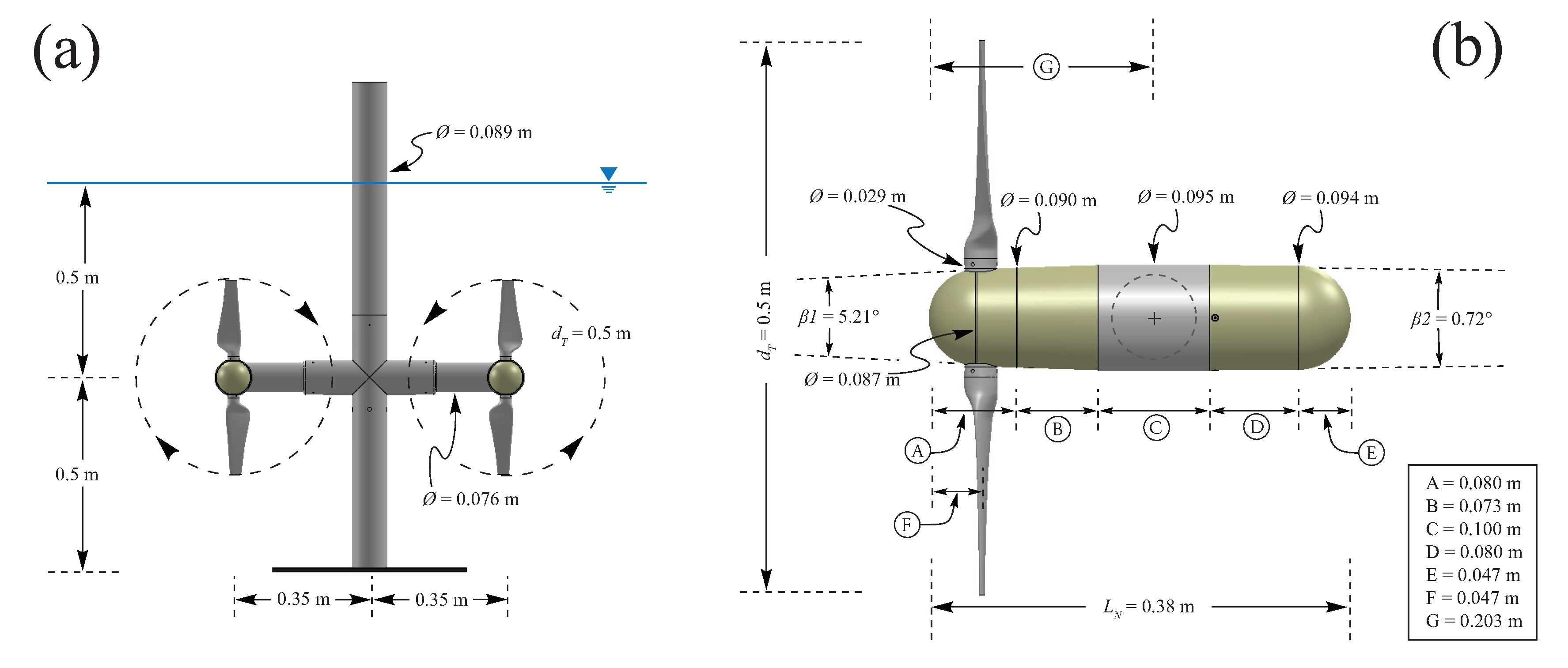
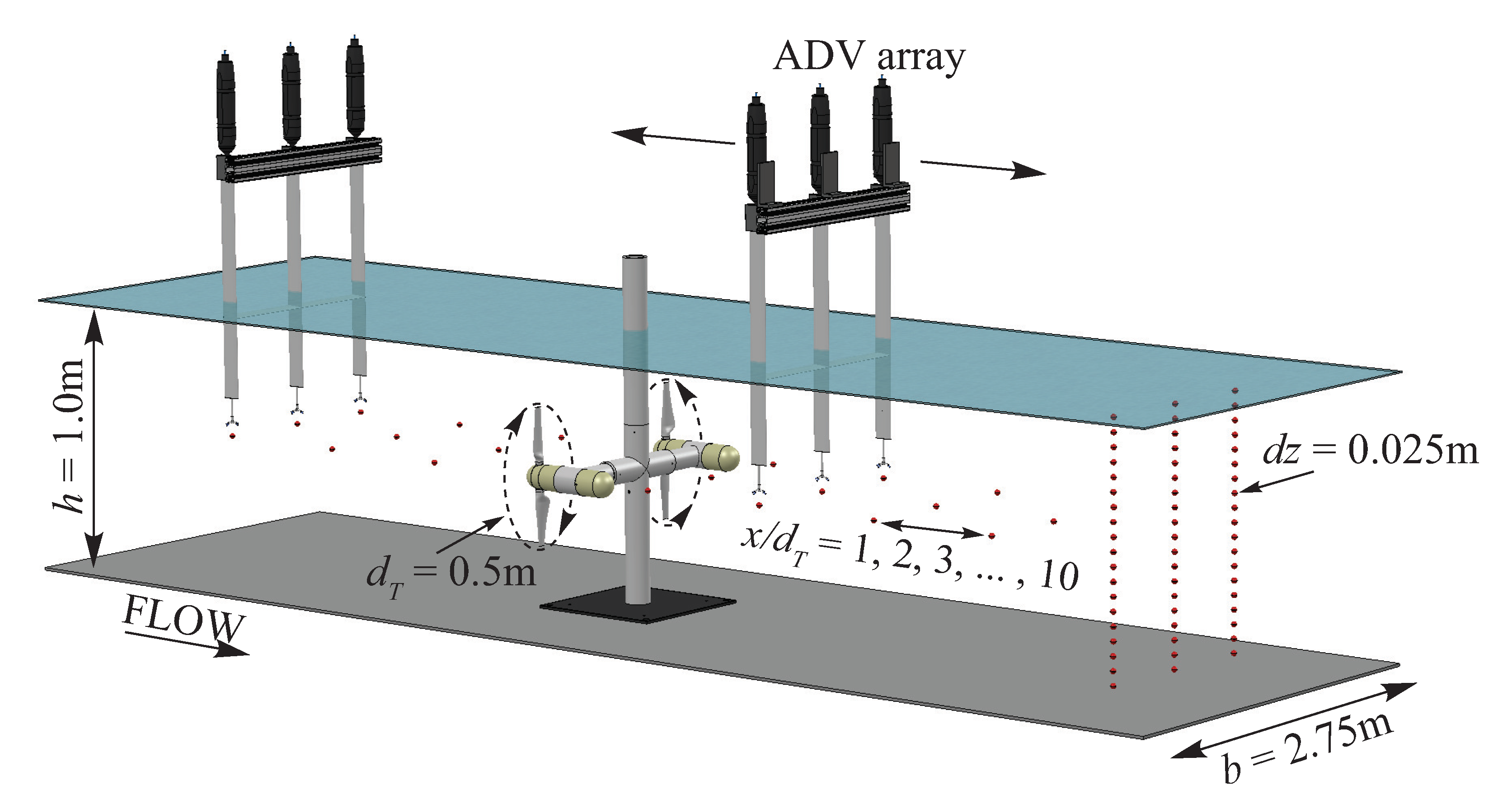

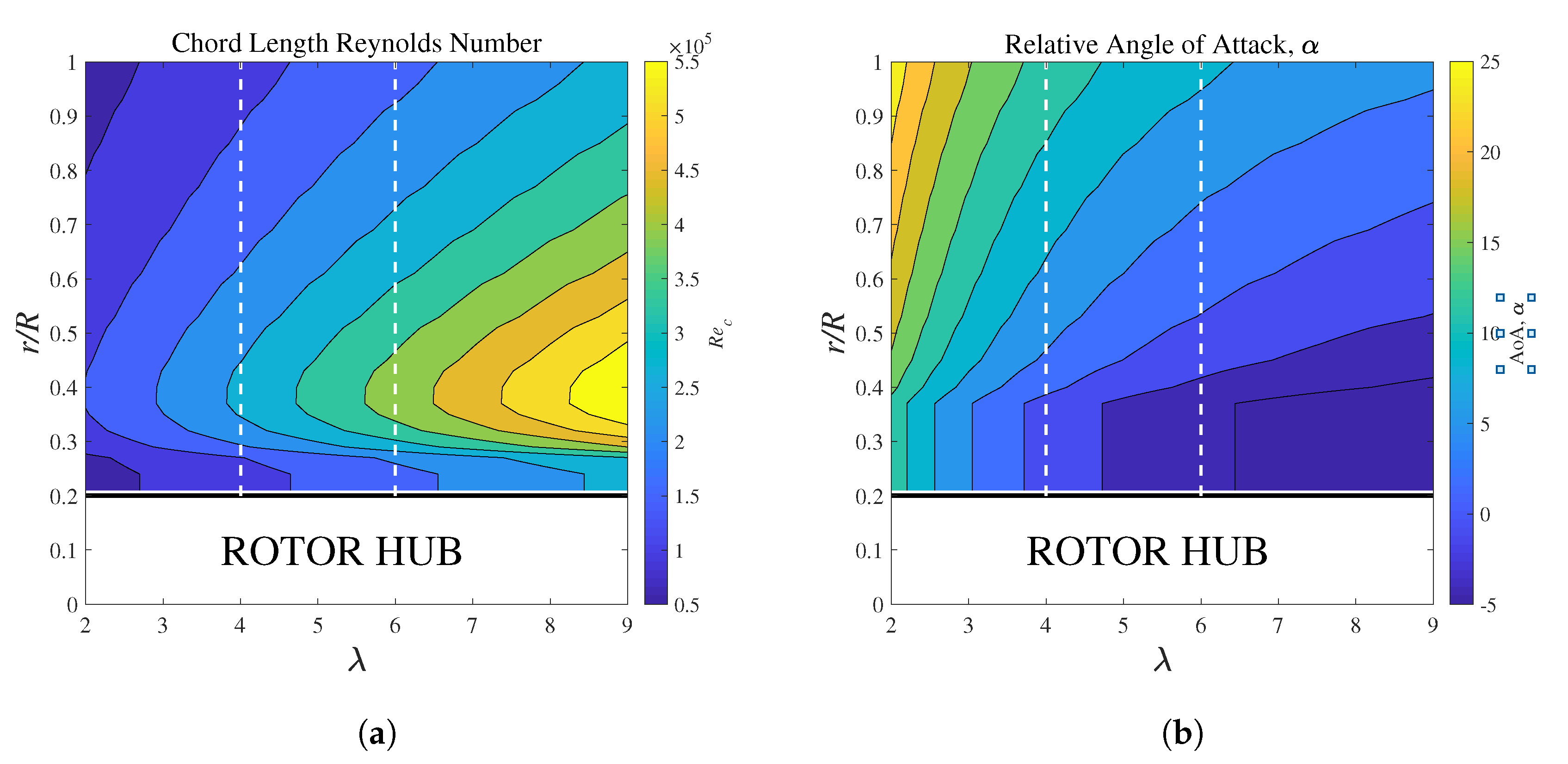

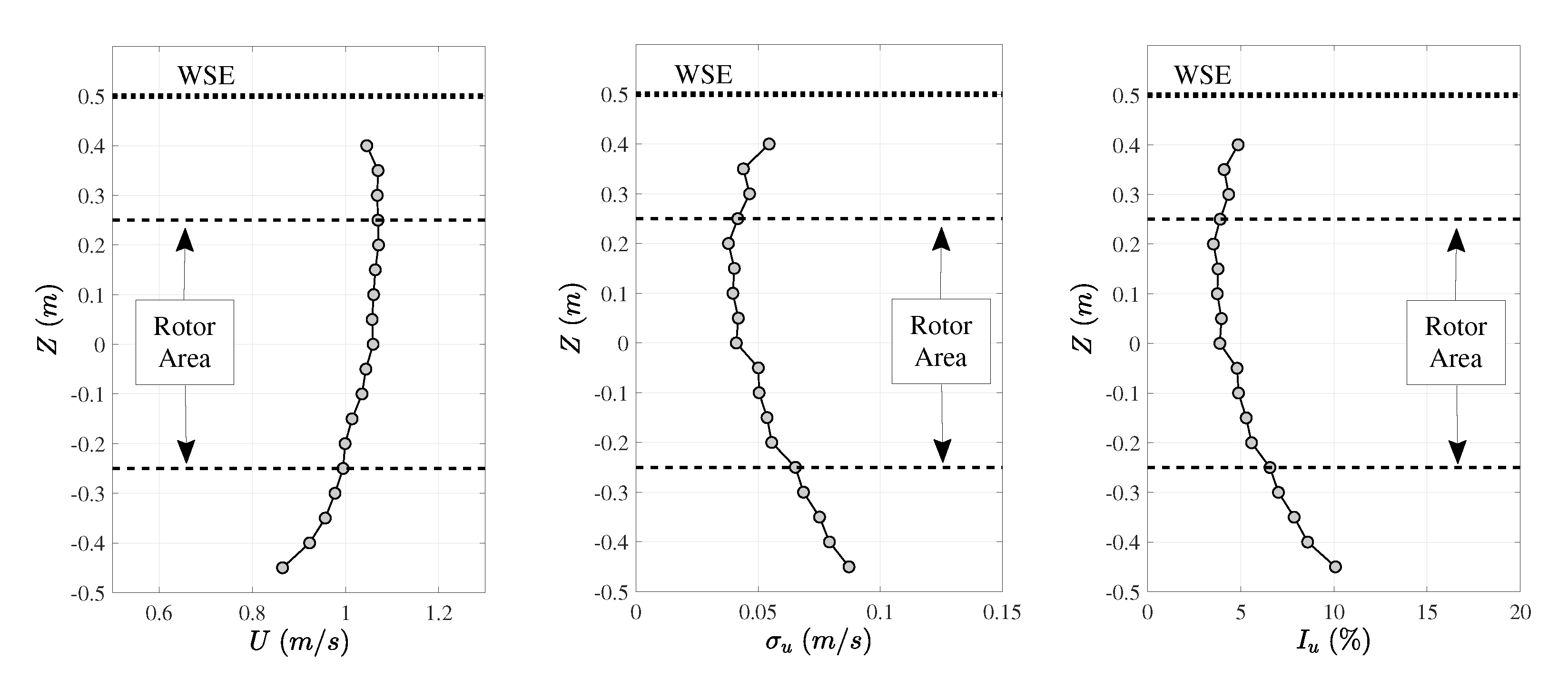

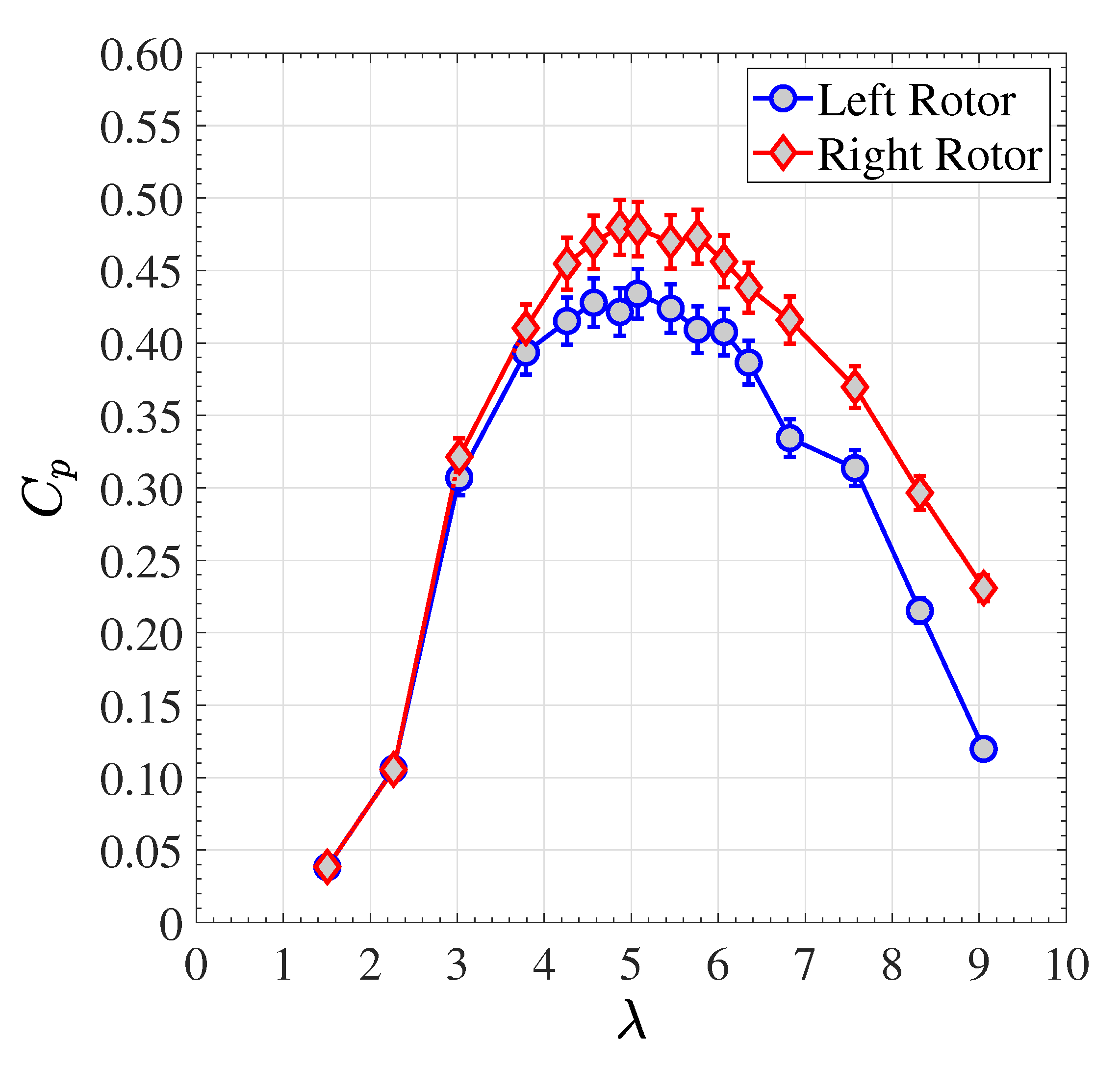
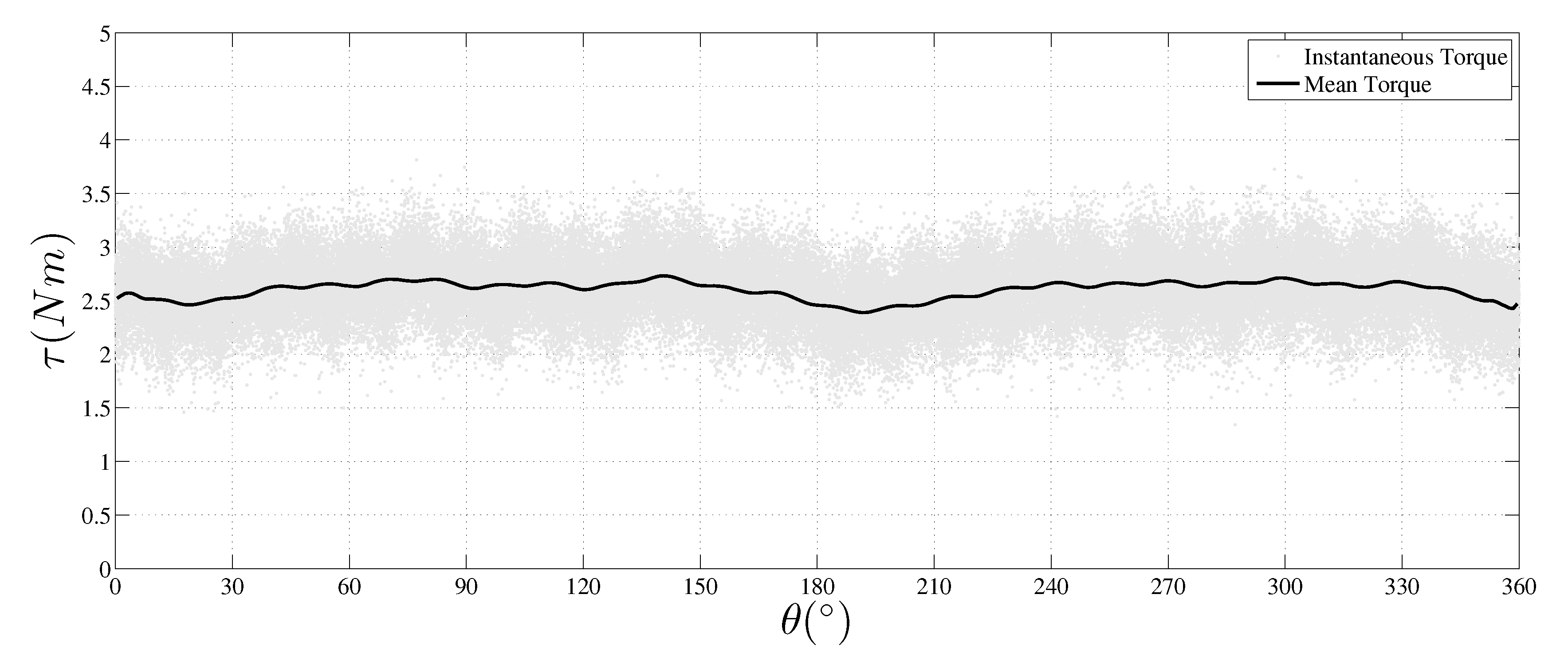
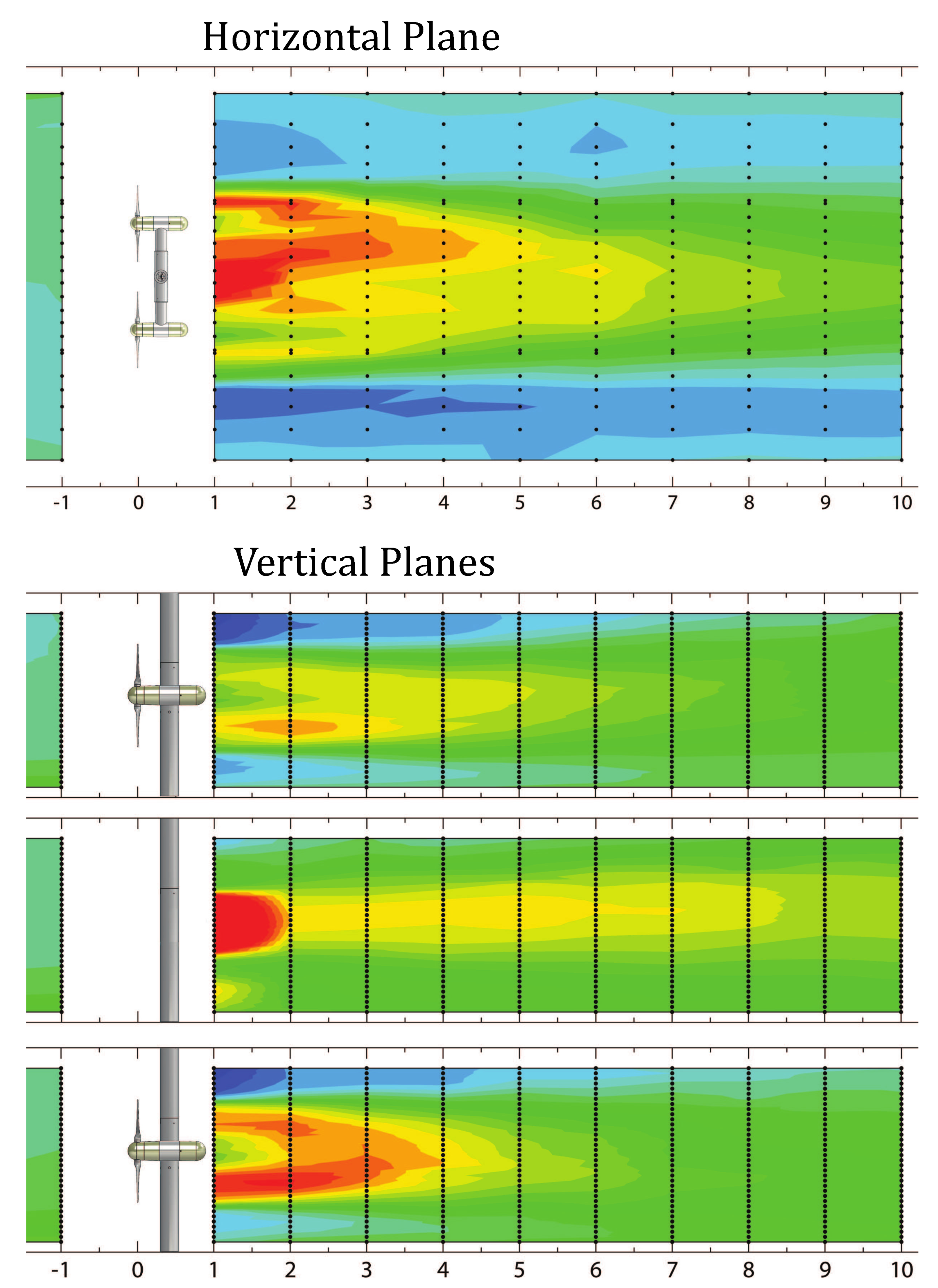
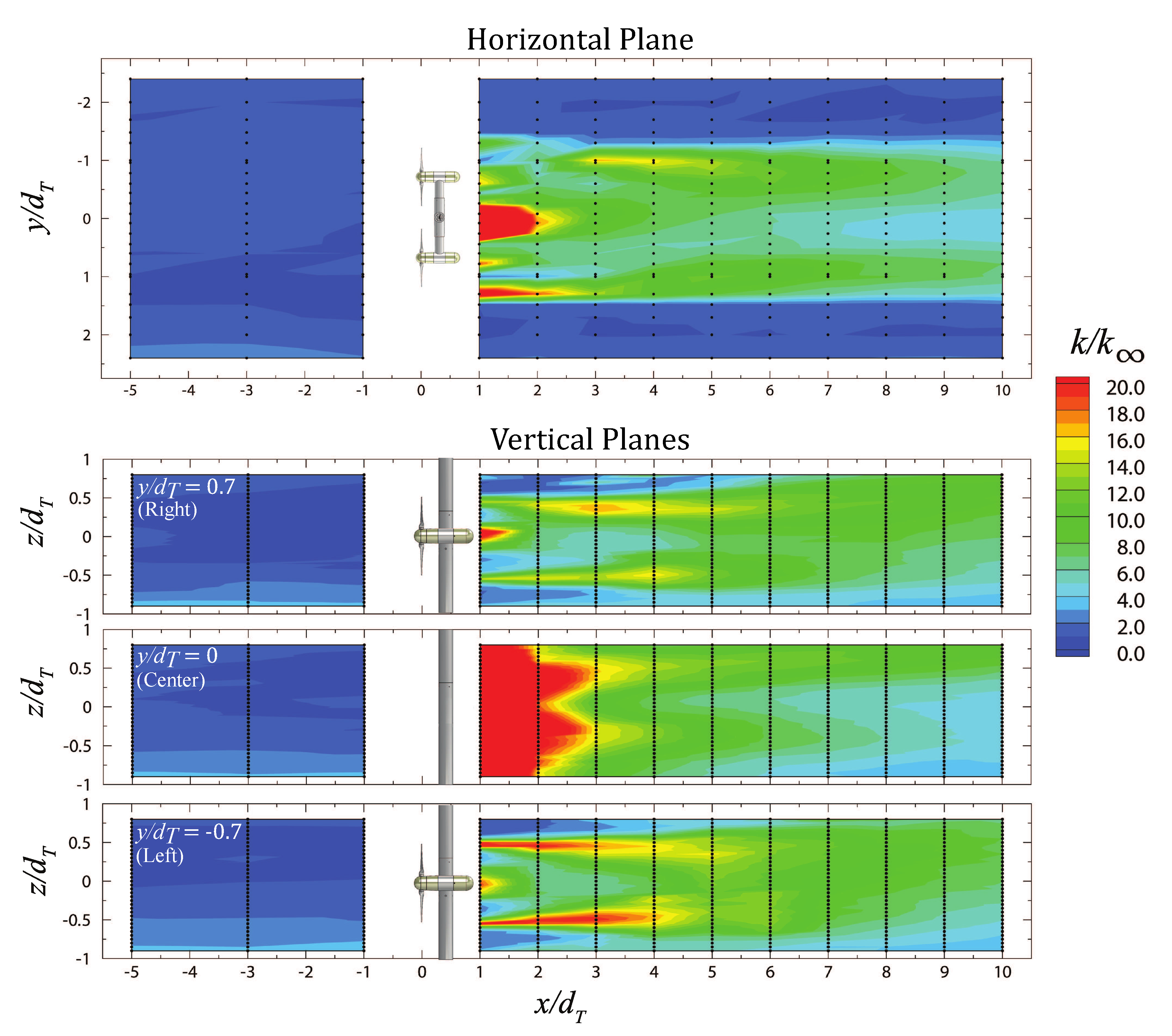
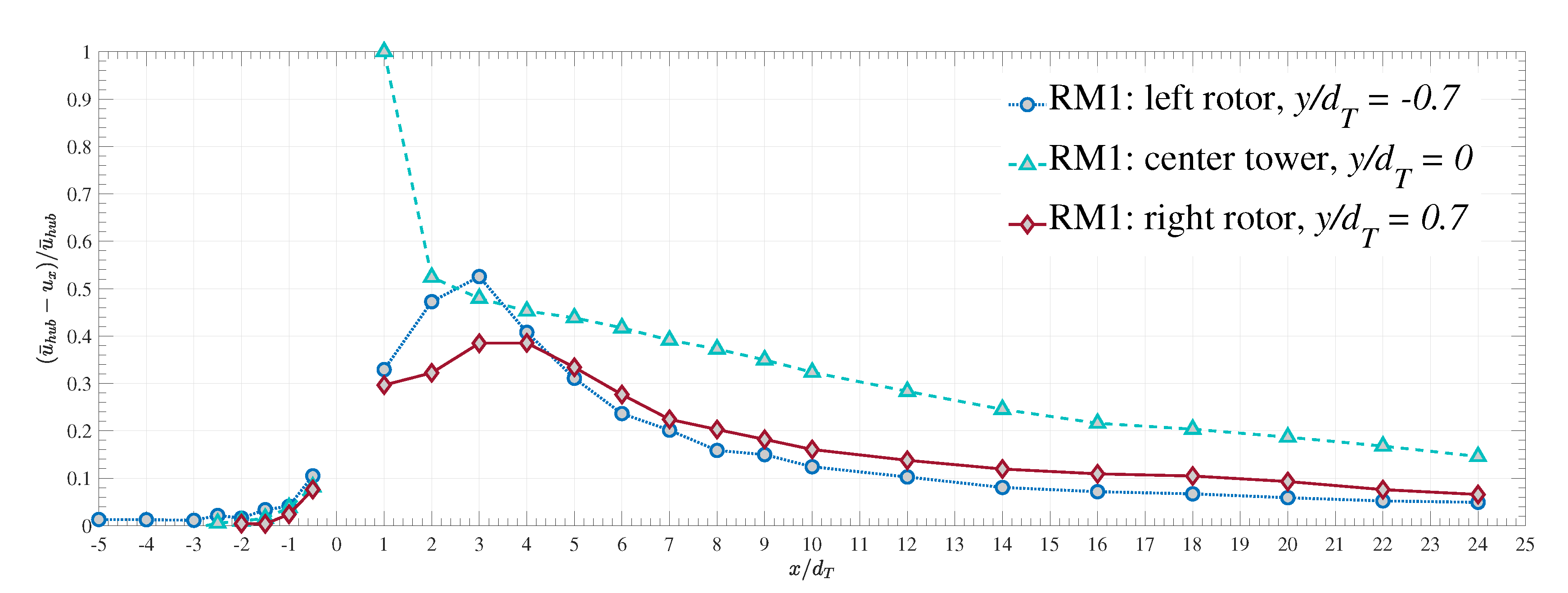
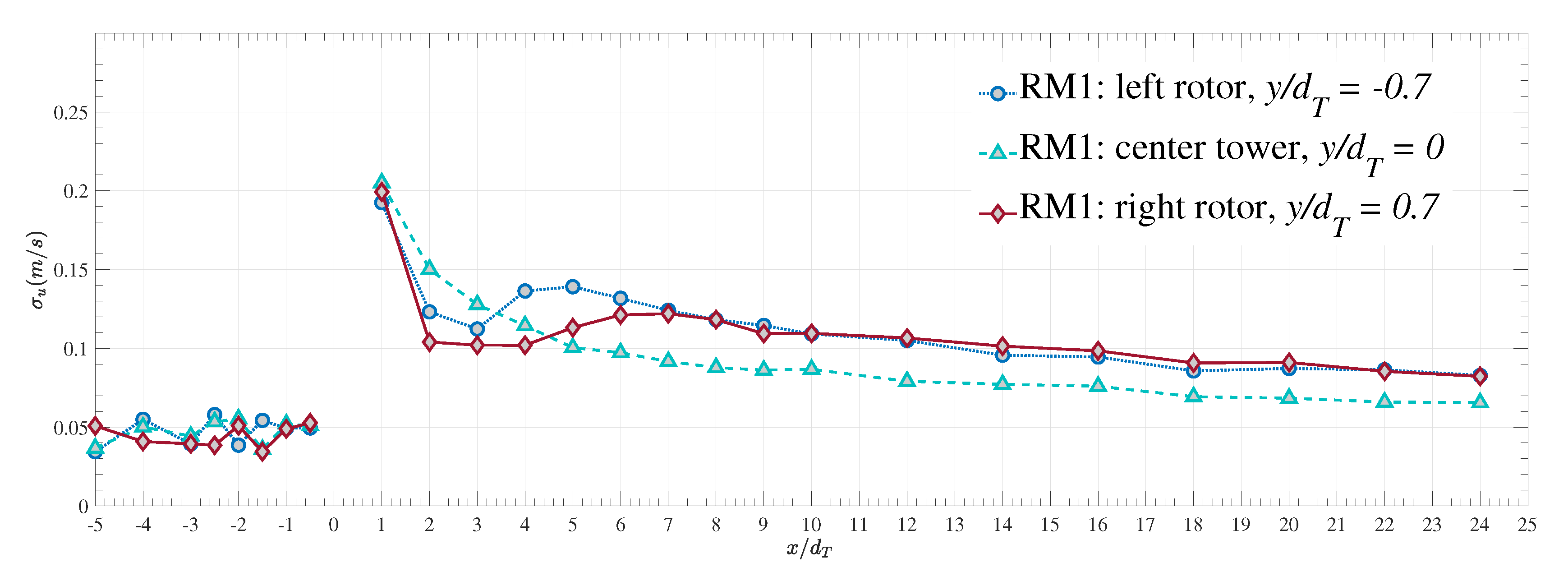
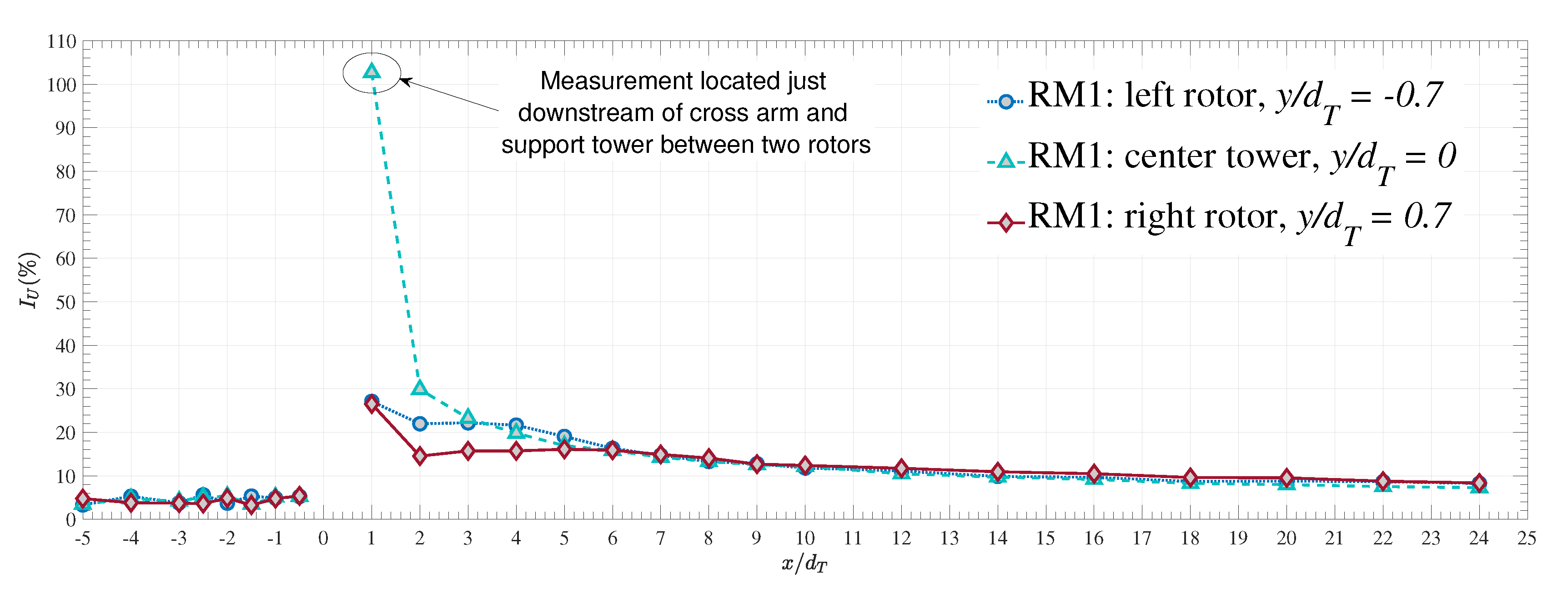
| Parameter | 1:40 Model |
|---|---|
| 2.425 ms | |
| h | 1.0 m |
| 18.0–20.5 °C | |
| 1.04 ms | |
| 0.28 | |
| at | 3.1 × 10 |
| 4.4 × 10 | |
| 4415 | |
| 0.5 m | |
| 0.5 m | |
| 13.7% | |
| 14.3% | |
| 1 to 9 |
© 2020 by the authors. Licensee MDPI, Basel, Switzerland. This article is an open access article distributed under the terms and conditions of the Creative Commons Attribution (CC BY) license (http://creativecommons.org/licenses/by/4.0/).
Share and Cite
Hill, C.; Neary, V.S.; Guala, M.; Sotiropoulos, F. Performance and Wake Characterization of a Model Hydrokinetic Turbine: The Reference Model 1 (RM1) Dual Rotor Tidal Energy Converter. Energies 2020, 13, 5145. https://doi.org/10.3390/en13195145
Hill C, Neary VS, Guala M, Sotiropoulos F. Performance and Wake Characterization of a Model Hydrokinetic Turbine: The Reference Model 1 (RM1) Dual Rotor Tidal Energy Converter. Energies. 2020; 13(19):5145. https://doi.org/10.3390/en13195145
Chicago/Turabian StyleHill, Craig, Vincent S. Neary, Michele Guala, and Fotis Sotiropoulos. 2020. "Performance and Wake Characterization of a Model Hydrokinetic Turbine: The Reference Model 1 (RM1) Dual Rotor Tidal Energy Converter" Energies 13, no. 19: 5145. https://doi.org/10.3390/en13195145
APA StyleHill, C., Neary, V. S., Guala, M., & Sotiropoulos, F. (2020). Performance and Wake Characterization of a Model Hydrokinetic Turbine: The Reference Model 1 (RM1) Dual Rotor Tidal Energy Converter. Energies, 13(19), 5145. https://doi.org/10.3390/en13195145




